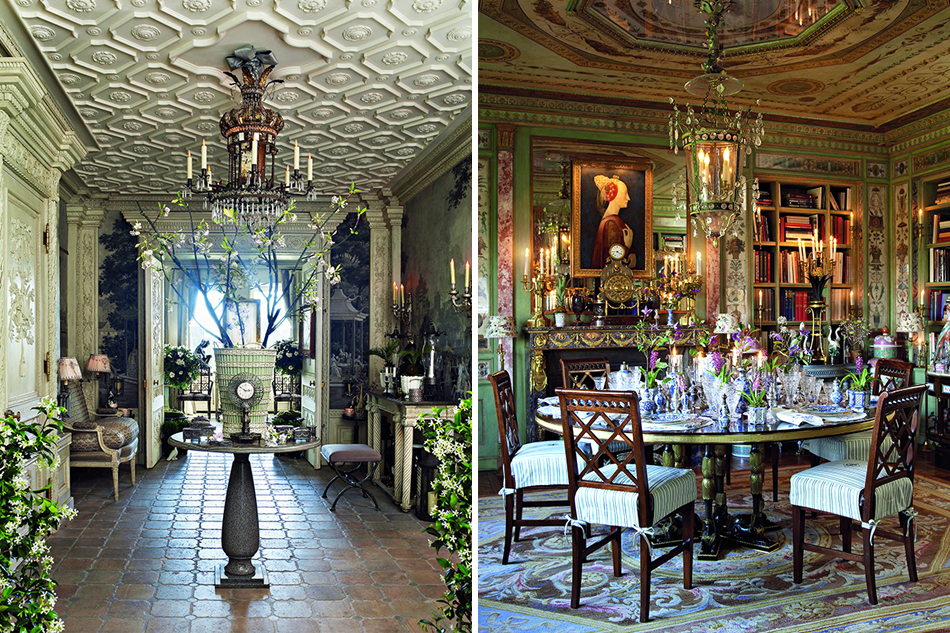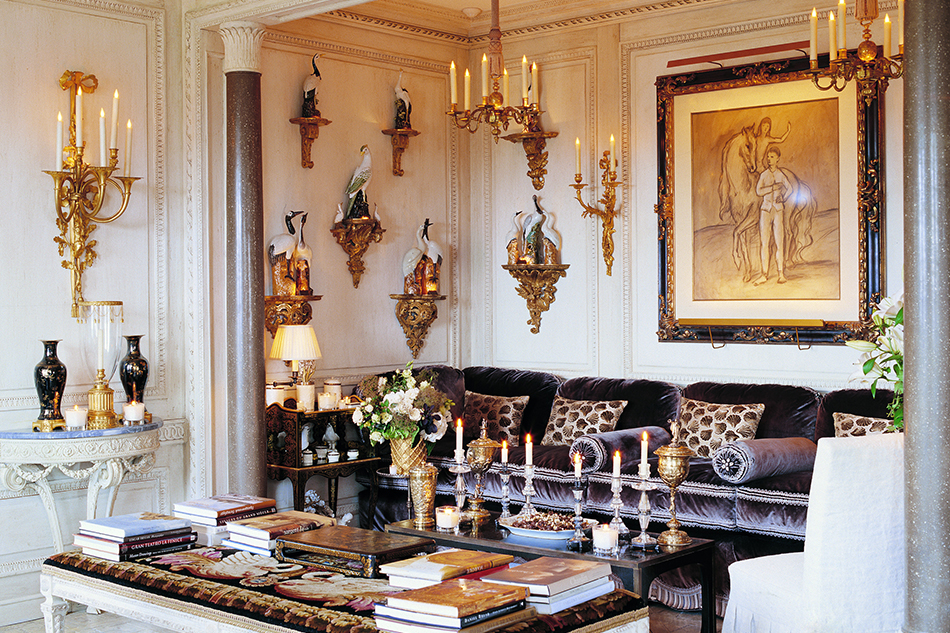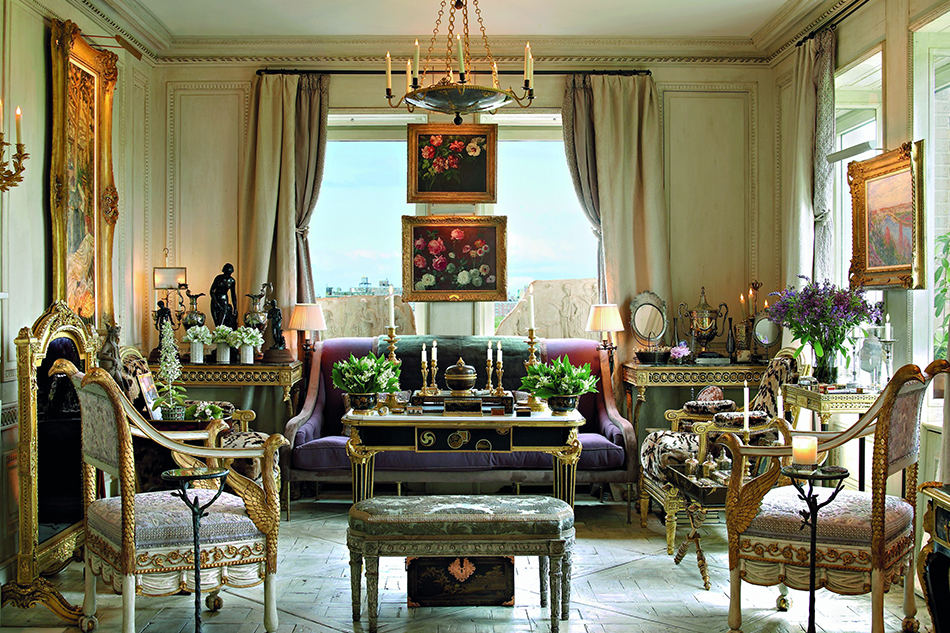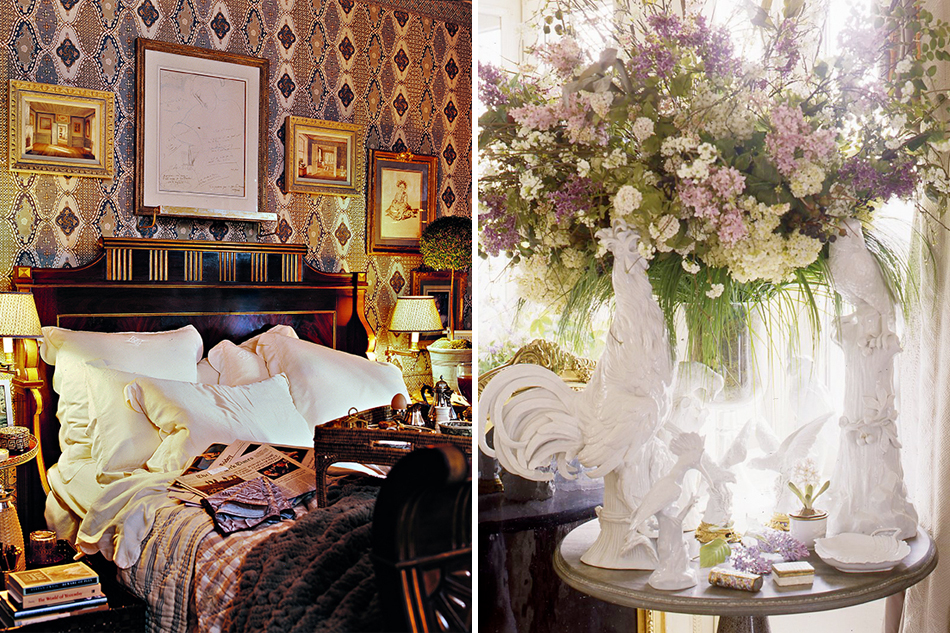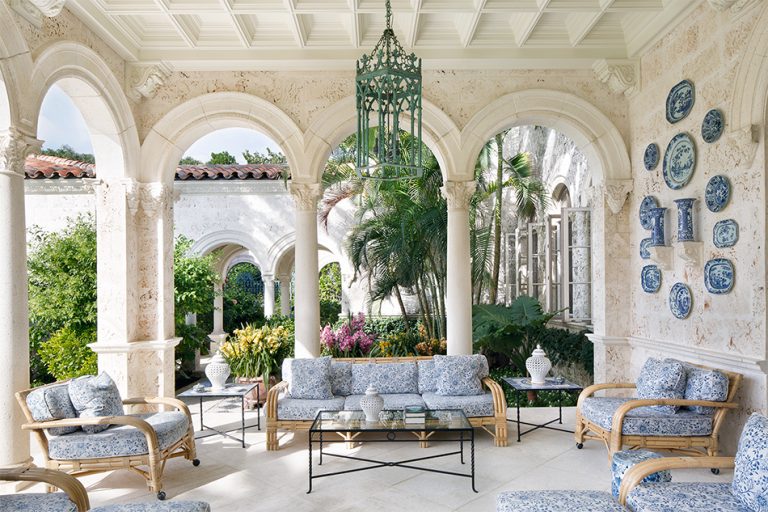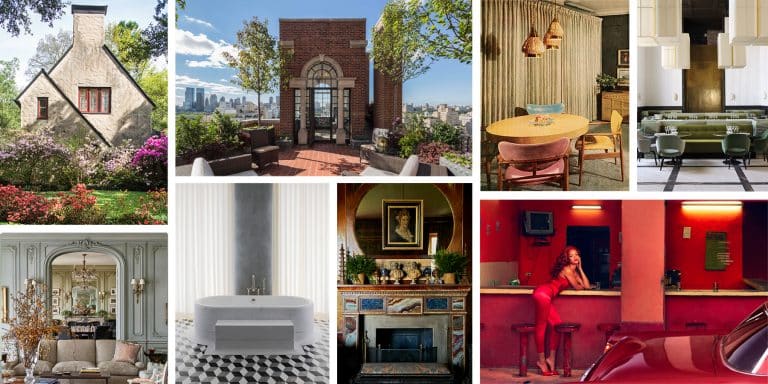
October 23, 2013Howard Slatkin, with his Norwich terrier, Winnie, purchased his New York apartment 17 years ago and spent nearly three years on renovations. Top: Slatkin maintains that every room should have a mirror, as they add “life and mystery.” Here the mirrored doors that connect the living and dining rooms reflect the light from the windows. All photos © Tria Giovan/Vendome Press
This month, the Vendome Press is publishing Fifth Avenue Style: A Designer’s New York Apartment by Howard S. Slatkin, a shy, publicity-averse interior designer who creates grand homes for some of the most private clients in America and Europe.
Introspective recently spoke with Slatkin to discuss the book, which documents the multiyear transformation of a 6,000-square-foot pre-war co-op on upper Fifth Avenue. The lucky client who allowed us to take a look? Slatkin himself.
Why did you write this book?
Three years ago, when my beloved mother was dying of cancer, she asked me to, and I promised her I would. She knew I was private and reticent and did not seek the limelight, but she wanted there to be a record of at least one project. And she thought I wrote well — as prejudiced mothers do.
You began decorating at age 23, never worked in anyone else’s firm and cite the late Baroness Liliane de Rothschild, a renowned Paris tastemaker, as an influence. That’s quite a trajectory.
You know, sometimes I wonder myself how it all happened, to tell you the truth. A hell of a lot of luck, I guess. In spades. A friend of the family knew her and invited me to lunch with her in Paris. She didn’t let many people get close, but we hit it off, and we ended up going to exhibitions and museums together for six months. Then I came to know her children. What Liliane taught me, by example, was how to live with extraordinary possessions, but in rooms of great comfort and charm. Downright cozy. Never intimidating. A very rare accomplishment.

For the dining room, Slatkin took inspiration from Raphael’s Loggia at the Vatican. The eau de nil color of the trim brings Central Park into the room.
Your lavish style is unique. How do you characterize it?
I like to think I don’t have a particular style. It all depends upon the location of the home, the architecture, what is appropriate and the client’s lifestyle — his or her collections, possessions, et cetera. I like to think all my work is deeply personal, does not follow fashion and is defined by a certain sense of quality, craftsmanship, great comfort and, of course, beauty.
You say another major mentor was the legendary Paris decorator Henri Samuel and that Italian designer Renzo Mongiardino was an influence. What in your apartment reflects their tastes?
I can’t think of something specific that could be pointed to as a direct influence of Henri or Renzo. It was more that when I was in my mid-2os they taught me to listen to my own mind, to follow my own path, and about the importance of working with great craftsmen to help me realize my dreams. Their powerful message was to dream, to not follow convention.
What are your favorite sources of inspiration: international travel, books, museums, paintings, photographs?
All of the above! It is about seeing everything, a certain curiosity about art, architecture, gardens — the whole visual kaleidoscope of life — wherever it is, be it through travel, books, museums, visiting private homes, and keeping one’s eyes open. That is the key: not to just look, but to see. A quote from Helen Keller has always resonated with me: “The only thing worse than being blind is having sight but no vision.”

A testament to Slatkin’s network of skilled craftsmen, the picturesque wood floor, walls, cabinetry and ceiling tiles in the kitchen were all newly made for the room.
You write lovingly about the Russian imperial palace Pavlovsk, the Florentine room of Schloss Favorite in Baden-Baden and Raphael’s Loggia at the Vatican. Have you seen these places in person?
Yes, I have visited each — many times.
And when you were there, did you stop dead in your tracks and start sketching or taking photos?
Stopped dead in my tracks and held my breath and got lightheaded! Then I would indeed sketch and photograph. But perhaps most important, I really, really look. To be in the moment and soak in what is in front of me, to focus and get the message.
In the book, you say that when you were apartment hunting, you made a list of non-negotiables: great Central Park view, 11-foot ceilings, serious square-footage and a pre-war co-op that you would have no hesitation about gutting.
The apartment, my 30th birthday present to myself, was a handyman’s special. I reconfigured the entire space. I wanted an enfilade of rooms, with an entry gallery leading to a formal living room and dining room overlooking the park, a schatzkammer-style library, a bedroom master suite, a screening room, guest room, kitchen and several “service” rooms. In the book, I include my floor plan and then devote a chapter to each room, showing the decisions I made and the reasoning behind them. It’s all about my personal taste and prejudices.

“I knew I wanted to create a room in which my guests would feel that they were spending the night in a magical garden,” writes Slatkin of this room with its lit à la polonaise topped with voile scarves and surrounded by hand-painted 18th-century Chinese wallpaper.
You have a fantastic array of luxury fabrics in the apartment: antique textiles, passementerie, custom embroideries, silk-taffeta curtains and cashmere upholstery. Why did you start designing custom fabrics?
Quite simply, I wanted what I saw in my mind and did not just want to rely on what was available at that moment in the marketplace. So I would design a pattern and have it made. Clients like having things unique to just them, like couture. Of course, it is much more work. I did toy with the title of my book being: He Did It The Hard Way.
Are you obsessed with textiles?
Yes, totally. Textiles are the soul of our homes. They are tactile, give beauty and come in infinite variety. The workmanship can be astounding. Woven, printed or embroidered — they are the paint I use to make my pictures.
And how did you find Lesage, Paris’s greatest embroiderer?
A friend introduced me to Jean-Francois Lesage when I was starting my career. If you work with artisans and respect them and treat them well and reward them appropriately, they pass the word and doors open all over the world. People always say there are no more great craftsmen. Nonsense. They just don’t know where to look or are lazy. I always remember Mongiardino telling me, when I was about 25, “Your craftsmen are your most valuable assets; they make your dreams a reality. They are far more valuable than clients, as there are always more billionaires needing nice houses, but it’s not so easy to find great talent.”

A bronze of Venus after Giambologna appears to be gazing out at Central Park. A view of the park was one of Slatkin’s top priorities when searching for his dream apartment.
Your apartment is chock-a-block with antiques. What’s your philosophy about decorating with them?
A home needs things of all levels and qualities to be special, to have charm. What unites antiques is not a common price tag but the fact that they give pleasure.
Have you ever bought an antique sight unseen from a website?
Yes, for convenience, and because it was “right,” and I didn’t want to lose it.
How can you manage an office and still maintain an intimate relationship with a client, keeping it on a one-to-one basis?
I take very few projects and very few clients at one time. I do not need to have lots of projects at once, as then I am just managing and running a business. I did that years ago and ended up leaving design for a while as it was no longer rewarding. I had lost the pleasure and time to do what I love and am best at: the actual design. What keeps me in design is the design work, the pleasure of all the details, the fussing over them all. And working with my clients, whom I love in almost every case.

An advocate of mixing styles to suit one’s own taste, Slatkin combined a pair of 18th-century Italian console tables with Chinese export porcelain birds and a French athénienne candelabrum topped by a gilt-bronze pineapple.
You say what makes a house a home is that not everything in it is “good.” Is there anything in your apartment that is not great?
“Great” is relative. I could argue that I have pretty things that give me pleasure but not a thing that is great in the sense of “important,” as many of my clients have. And when clients do have the best of everything, I then try very hard to give their rooms charm, ease and comfort — despite all the great things. To bring it down, to humanize the rooms. It is much easier said than done.
When arranging things in a room, do you think like a curator?
Not one bit. Before becoming a designer, I had internships at the Metropolitan Museum (in European sculpture and arts under William Rieder), at the Cooper-Hewitt (under David McFadden) and at the Morgan Library, so I know the intellectual discipline and rigor of a curator. In fact, I want the opposite of a curatorially correct room. I want life and air and charm, and comfort for how we live today, and a bit of the unorthodox, the very personal.
Do you think objects define the experience of the visitor?
It depends on the visitor. I like to think that it is the general atmosphere of a room that is the experience a guest takes with him, not just the image of an object or picture that caught his eye, but rather some elusive mysterious something that can’t quite be articulated. You know the feeling you get after visiting someone’s home that was incredible and the next day you can’t describe it? It’s indescribable.
PURCHASE THIS BOOK
or support your local bookstore

